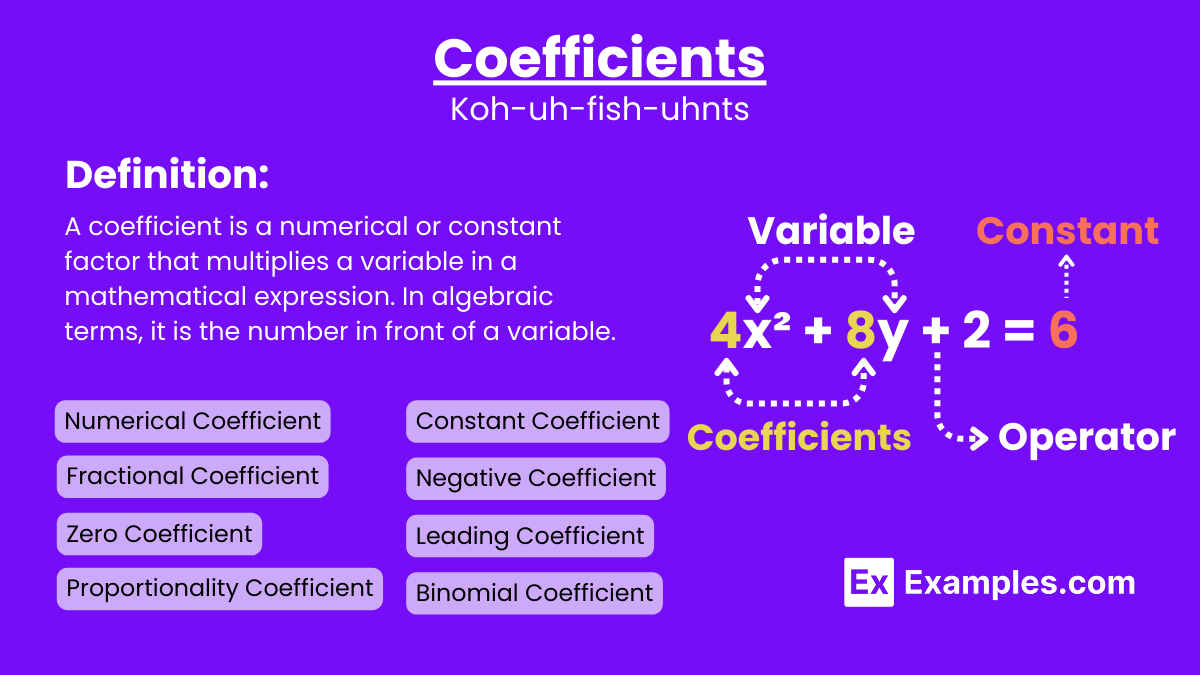In the polynomial \(3x^2 + 5x - 7\), what is the coefficient of \(x\)?
3
-7
5
7


Coefficients are numerical values placed in front of variables in mathematical expressions to indicate multiplication. For example, in 3𝒙, 3 is the coefficient of the variable 𝒙. Coefficients quantify the contribution of the variable to the expression, playing a crucial role in algebraic equations, polynomials expressions, and various mathematical calculations.
Coefficients are fundamental in algebra, as they quantify the contribution of variables in equations and functions, allowing for the manipulation and solving of mathematical problems. They are used extensively in various fields, including physics, engineering, and economics, to model relationships and predict outcomes.
A coefficient is a numerical factor that multiplies a variable in an algebraic expression. For example, in the term 5x, the coefficient is 5, meaning 5 times x. If the term is −3y, the coefficient is −3, and in 1/2 z, the coefficient is 1/2. When a variable stands alone, like x, the coefficient is implicitly 1. Coefficients help in simplifying expressions, such as combining 2x+3x to get 5x, and in solving equations, like solving 2x=10 by dividing both sides by the coefficient 2, resulting in x=5.
A numerical coefficient is the constant numerical factor that multiplies the variables in an algebraic term. It quantifies the contribution of the variable(s) in the term. For example, in the expression 4𝒙y, the numerical coefficient is 4, indicating that 𝒙y is multiplied by 4. In −3a²b, the numerical coefficient is -3. Identifying numerical coefficients is essential for simplifying, solving, and understanding algebraic expressions and equations.

The leading coefficient is the numerical coefficient of the term with the highest degree in a polynomial. It is the coefficient of the term with the greatest exponent when the polynomial is written in standard form (terms in descending order of their exponents). The leading coefficient plays a crucial role in determining the polynomial’s behavior, especially its end behavior.
In the polynomial 3𝒙⁴+2𝒙³−5𝒙+7, the leading coefficient is 3, as 3𝒙⁴ is the term with the highest degree.
For the polynomial −7𝒙⁵+4𝒙³+𝒙−2, the leading coefficient is -7, as −7𝒙⁵ is the term with the highest degree.
1. Numerical Coefficient:
2. Constant Coefficient:
3. Fractional Coefficient:
4. Negative Coefficient:
5. Zero Coefficient:
6. Leading Coefficient:
7. Proportionality Coefficient:
8. Binomial Coefficient:
| Simplify: Expression: 6x Solution: Coefficient: 6 | Simplify: Expression: −4y Solution: Coefficient: -4 |
| Simplify: Expression: 3a²b Solution: Coefficient: 3 | Simplify: Expression: 7x³ + 2x Solution: Coefficient of x³: 7 Coefficient of x: 2 |
| Simplify: Expression: −5m²n+9n Solution: Coefficient of m²n: -5 Coefficient of n: 9 | Simplify: Expression: x Solution: Coefficient: 1 (implicit) |
| Simplify: Expression: −z Solution: Coefficient: -1 (implicit) | Simplify: Expression: 4p²q³ Solution: Coefficient: 4 |
| Simplify: Expression: 8t−3t² Solution: Coefficient of t: 8 Coefficient of t²: -3 | Simplify: Expression: 2x⁴−7x²+x−5 Solution: Coefficient of x⁴: 2 Coefficient of x²: -7 Coefficient of x: 1 (implicit) |
To identify the coefficient, look for the number directly in front of the variable. For example, in 5x, the coefficient is 5.
The leading coefficient is the coefficient of the term with the highest degree in a polynomial. It is significant in determining the polynomial’s behavior.
Yes, coefficients can be negative. For example, in −4y, the coefficient is -4.
The coefficients determine the steepness, direction, and width of the graph of a polynomial. The leading coefficient, in particular, affects the end behavior of the graph.
Identify the numerical part that multiplies all the variables. For example, in 5x²y, the coefficient is 5.
No, coefficients can be any real numbers, including fractions and decimals. For example, in 0.5x, the coefficient is 0.5.
Yes, a coefficient can be zero, which means the term does not contribute to the expression. For example, in
0⋅x, the term is effectively zero.
In calculus, the coefficient of a term in a polynomial is multiplied by the exponent during differentiation. For example, the derivative of
5𝑥³ is 15𝑥² (5 multiplied by 3).
In systems of equations, coefficients are used to form the equations that describe the relationships between variables. They are key in methods like substitution and elimination.
An implicit coefficient is the coefficient that is understood to be 1 if no number is written in front of the variable. For example, in x, the coefficient is implicitly 1.
Text prompt
Add Tone
10 Examples of Public speaking
20 Examples of Gas lighting
In the polynomial \(3x^2 + 5x - 7\), what is the coefficient of \(x\)?
3
-7
5
7
What is the coefficient of \(x^3\) in the polynomial \(4x^3 - 2x^2 + 7x - 1\)?
4
-2
6
-1
In the expression \(2a^2b - 3ab^2 + 4b\), what is the coefficient of \(ab^2\)
2
-3
4
6
What is the coefficient of \(y^2\) in the polynomial \(5x^2 - 3xy^2 + 2y^2\)?
5
-3
2
0
In the polynomial \(7x^3 + 4x^2 - x + 6\), what is the coefficient of the constant term?
7
4
-1
6
What is the coefficient of \(x^2\) in the polynomial \(9x^3 - 4x^2 + 2x + 8\)?
9
-4
2
8
In the polynomial \(6a - 3b + 4ab\), what is the coefficient of \(a\)?
6
-3
5
7
What is the coefficient of \(x\) in the polynomial \(2x^3 + 7x - 9\)?
2
7
-9
0
In the polynomial \(x^2 - 5x + 6\), what is the coefficient of \(x^2\)?
-5
6
1
0
What is the coefficient of \(z^2\) in the polynomial \(3z^3 - 2z^2 + z + 4\)?
3
-2
1
4
Before you leave, take our quick quiz to enhance your learning!

